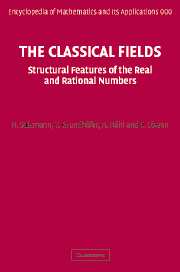5 - The p-adic numbers
Published online by Cambridge University Press: 07 May 2010
Summary
The idea of p-adic numbers is due to Hensel, who was inspired by local power series expansions of meromorphic functions (see Warner 1989 p. 469f, Ebbinghaus et al. 1991 Chapter 6 and Ullrich 1998). We treat the p-adic numbers as relatives of the real numbers. In fact, completion of the rational field ℚ with respect to an absolute value leads either to the reals ℝ or to a field ℚp of p-adic numbers, where p is a prime number (see 44.9, 44.10, 51.4, 55.4), and these fields are locally compact. We consider the additive and the multiplicative group of ℚp in Sections 52 and 53, and we study squares and quadratic forms over ℚp in Section 54. It turns out (see 53.2) that the additive and the multiplicative group of ℚp are locally isomorphic, in the sense that some open (and compact) subgroup of ℚ×p is isomorphic to an open subgroup of ℚ+p; this is similar to the situation for ℝ.
Comparing ℝ and ℚp, it appears that the structure of ℚp is dominated much more by algebraic and number theoretic features. A major topological difference between the locally compact fields ℝ and ℚp is the fact that ℝ is connected and ℚp is totally disconnected (51.10). Moreover, ℚp cannot be made into an ordered field (54.2).
In Sections 55–58 we put the fields ℚp in the context of general topological fields: we study absolute values, valuations and the corresponding topologies. Section 58 deals with the classification of all locally compact fields and skew fields.
- Type
- Chapter
- Information
- The Classical FieldsStructural Features of the Real and Rational Numbers, pp. 278 - 334Publisher: Cambridge University PressPrint publication year: 2007



